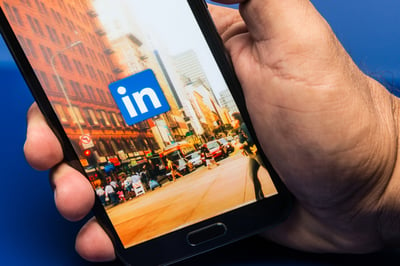September 13, 2019
 by Julia Manoukian / September 13, 2019
by Julia Manoukian / September 13, 2019

Think of when you’re researching to a book a vacation or trip. Details about different locales and customer reviews capture your attention, right?
But the most impactful type of content when it comes to travel and tourism are visuals is user-generated content (UGC). And the same goes for your potential customers.
Visual content that accompanies written details about a destination isn’t just for decoration and to spice up a web page, ad, social media post, or brochure. Visuals, and in particular, UGC, are an important driver in the decision-making process for travelers, and can actually lead to greater conversions.
This makes UGC a key part of any successful marketing strategy at any company — but specifically for travel and hospitality brands. In fact, more than half of travelers 18 to 65 say they’ve booked a trip before based on the posts they’ve seen on Instagram. That’s a pretty significant number.
It’s simple to add a few photos and videos to your social media posts and website. But how do you actually know they’re making a difference?
Most marketers measure the impact of the visuals they use by inferring results from metrics like web traffic (before and after changing imagery) or seeing how many more likes/views they get of a specific post over others. But you can go deeper to see what other factors are contributing to a rise as well.
It’s critical to find a way to measure how these photos and videos are driving people to convert in order to justify your investment of resources, money, and time. These are the metrics you value most as a marketer, and the metrics that confirm a successful visual marketing strategy.
It’s no secret that visuals can be highly influential, generate brand awareness, and help drive conversions. Five months after adding UGC photos to its website, Dollywood family amusement park saw a 25 percent increase in engagement on its homepage, 28 percent increase in engagement on its waterpark page, and a 42 percent increase in engagement on the rides and attractions page.
In addition to posting photos, the company also embedded calls to action (CTA) links over images that led directly to ticket sales pages. Their galleries and CTAs directly led to $90,000 in ticket sales within five months.
But to quantify your results, like Dollywood, you need to crunch the numbers.
When looking at the visuals you’ve used, there are a few essential KPIs to measure your website performance. A few of the most common ones are listed below.
How do visitors who interact with these visuals compare to those who don’t? Are you noticing any influence on visitor behaviour thanks to compelling visuals?
After analyzing more than a million articles, BuzzSumo found that those with images every 75-100 words received double the social media shares versus those that didn’t use as many images. And Facebook posts with images tend to get 2.3 times more engagement than those without photos.
Visitor behavior itself isn’t necessarily a key performance indicator (KPI), but it is an aggregate of engagement metrics, and can give you a better understanding of what’s going on with your visitors.
Are people spending more time per visit on the website, looking at more pages, photos, and/or videos? And how does the time spent on the site by those who browsed through photos compare to those who didn’t? According 41.5% of marketers, unique visuals like UGC perform better than stock imagery.
For those who browsed through a set of visuals, did they look at more pages per visit than those who didn’t look through visuals? If so, you might have a winning strategy on hand.
Another important stat to analyze is the exit, or bounce rate: what page did visitors who browsed a set of visuals exit from versus those who did not browse a gallery?
Finally, the crème de la crème of marketing tactics that can lead to greater conversions is the call-to-action (CTA) conversion rate. Do your images increase conversion rates? If not, you need to switch them up.
Did visitors who browsed a set of visuals click through a CTA, and did they do so more often than visitors who did not browse that set of visuals?
As marketers, conversions are the ultimate goal! And if you notice that the numbers are noticeably higher when visuals are involved, it means the visuals are doing their job.
Now that we know what we should measure, let’s explore how to do it. The key to do this manually lies in Google Analytics. Create segments for people who have interacted with a set of visuals, then compare them with those who haven’t.
Google Analytics Segments lets you pull out and examine some parts of the data so you can respond to trends that you discover from doing so. Compare data in side-by-side reports using pre-defined segments or create your own.
Here’s how to do it:
Step 1: You’ll need to have Events set up for each set of visuals you want to analyze.
Step 2: Identify the dimensions, metrics, and scope for individual filters using the handy Segment builder. The scope can look at hits (behaviour confined to a single action, like viewing a page or clicking on a video), session (behaviour in a single session, like the amount of revenue a visitors generated), or user (behaviour across all sessions within a specific timeframe, up to 90 days).
Go to Audience > Overview > Add Segment > New Segment
Step 3: Go to advanced, conditions, and filter sessions to include event label. Each segment can contain up to 20 filters, and each filter can include multiple scopes (e.g. users whose revenue per hit was > 500).
Advanced > Conditions > Event Label > Contains
Step 4: Go back to your audience overview to see how visitors who interacted with a set of visuals compared to those who didn’t. You can see the average time on page, bounce/exit rate and more.
If you have Goals set up in Google Analytics, you can also see the goal conversion rate of people who interacted with a gallery vs those who didn’t. You’ll also be able to see the total dollar value of each segment. You can also do this at the Ecommerce level.
For both these segments, you should be aware of the placement of your visuals and how that contributes to the overall conversion rate and revenue influenced. For example, if you’re measuring your homepage header, it’s going to have a much higher influence than visuals closer to the bottom of the page.
Conversions > Goals > Overview or Ecommerce > Goals > Overview
Step 5: Calculate the revenue: see what percentage of the revenue the visuals influenced to figure out how much the visuals actually contributed to overall revenue.
Step 6: Don’t just post visuals, but add CTAs to them to further encourage conversion. Create a segment for everyone who clicked on the CTA and compare that to those who didn’t.
If you don’t have the know-how to do this in Google Analytics, you can use software to help. An analytics dashboard can pull key website performance metrics into a format that’s simple and easy to understand.
After analyzing the data, you can quantify how and if the visuals impacted marketing performance and share the results with your team to determine how to move forward.
When you find the best performing visuals, use them! Leverage their success through use in ads, on your website, and/or via your social media pages. Just don’t forget to get the rights to UGC first. Reach out to the user and ask for their permission.
So how do you choose the right visuals to meet your needs? Finding visuals to generate brand awareness and sourcing them from a stock pool, choosing what aligns with your brand and what might get the most Instagram likes is great. But you can do so much more to create a unique and personalized strategy that can help drive more direct bookings and ticket sales by considering UGC to supplement other visuals.
Browse what’s out there in terms of UGC using hashtags and keywords, reach out to users for permission, and create a gallery of amazing images that will speak to your audience much more effectively and authentically than text or stock imagery alone. Then, use the right tools or software to measure the impact in terms of interactions, influence, and conversions.
Consider that, just like you might have already shifted to a more data-driven approach for other strategies within marketing, including your company website, digital advertising, and content marketing, you should adopt the same mindset for visuals. They can have a far greater impact than you realize on pulling people in and getting them excited about your destination.
Want to learn more about optimizing your visual marketing strategy? Read about visual hierarchy, what is it, and see some visually-appealing examples to inspire your creativity.
Julia Manoukian is the Senior Content Marketing Manager at CrowdRiff, visual marketing software loved by 700+ travel and hospitality brands. A former journalist, Julia has helped multiple Toronto startups raise their thought leadership profiles and scale their content efforts to directly influence overall revenue. Julia has a passion for storytelling, travelling, and tech. You can find her on Twitter @juliamanoukian.
Digital engagement allows your business to connect with customers in many different ways.
 by Vanita Rana
by Vanita Rana
Which would you understand more easily - a block of text explaining how to tie a Double...
 by Kelly Wade
by Kelly Wade
LinkedIn has proven to be the most powerful social media for business people and salespeople.
 by George Rowlands
by George Rowlands
Digital engagement allows your business to connect with customers in many different ways.
 by Vanita Rana
by Vanita Rana
Which would you understand more easily - a block of text explaining how to tie a Double...
 by Kelly Wade
by Kelly Wade


